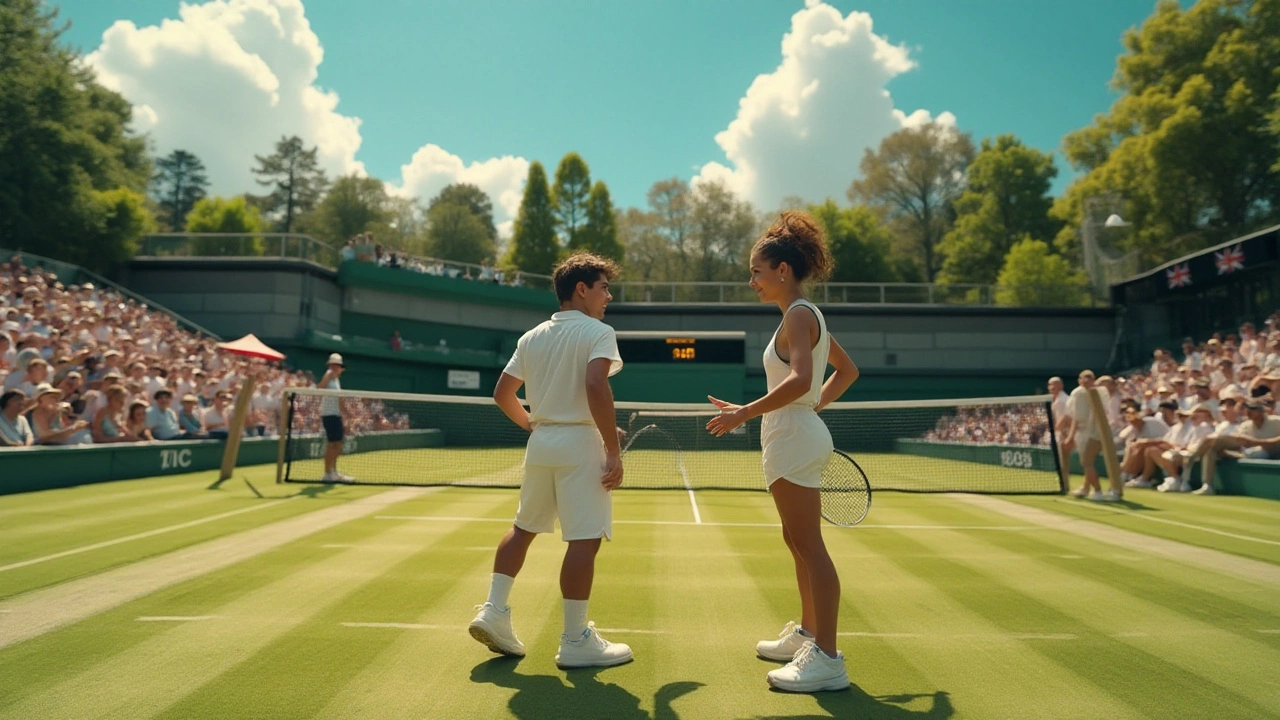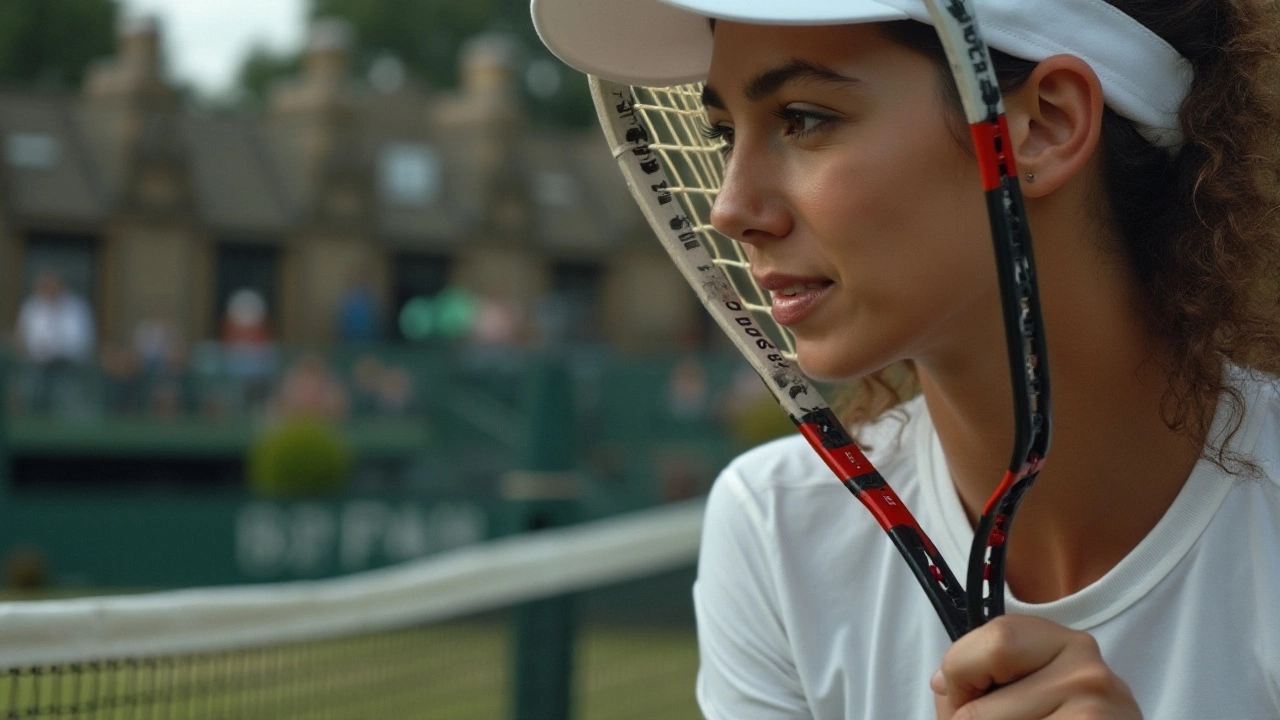Understanding Tennis Lingo: What Does PC Mean in Tournaments?
 Dec, 3 2024
Dec, 3 2024
For those new to the world of tennis, the sport can seem like it's speaking a foreign language. Amidst the love scores and break points, terms like 'PC' can leave fans scratching their heads. This isn't just jargon thrown around casually; it's an integral piece of the game.
Unpacking what PC means in tennis not only demystifies some of the lingo but also offers a deeper insight into how matches are run. It's a term that, once understood, can change how you view the strategies and dynamics of any tournament you watch. So, let's dive in and unravel what exactly PC stands for and why it holds significance in this beloved sport.
- Demystifying Tennis Terminology
- The Origin and Meaning of PC in Tennis
- PC's Role in Tournament Matches
- Common Misunderstandings About PC
- How PC Influences Match Outcomes
- Tips for Understanding Tennis Vocabulary
Demystifying Tennis Terminology
Tennis is a sport that bears rich traditions and heritage, woven with an array of unique terms that have evolved over time. These terms, such as 'love', 'deuce', and 'advantage', often seem perplexing, especially if you're a newcomer trying to grasp the game as quickly as Rafael Nadal takes to dominate a clay court. The charming appeal of the sport isn't solely about the prowess on the court but equally, the historical words that describe each swing, miss, and rally.
One might wonder where these words originate and why they are still in use. Going back in time, tennis terminology can be traced to its roots in France, where the game was played by noblemen in the 12th century. Words like 'deuce' derived from the French 'à deux de jeu', indicating a tie that requires two consecutive points to win. Delving deeper, 'love', meaning zero, is believed to have come from the French word 'l'oeuf', translating to egg, symbolizing the shape of a zero. Interestingly, tennis has held onto these terms not just for tradition, but because they add layers of metaphor that players and spectators alike appreciate.
The constantly evolving vernacular also incorporates modern terms, which keep the game contemporary yet grounded in its roots. The inclusion of terms like 'hawkeye', referring to the technologically-assisted line-call system, or 'tweener', describing a between-the-legs shot, indicates the dynamic nature of tennis. For seasoned enthusiasts, understanding these terms significantly enhances the experience, transforming the game from mere physical rallies to a profound narrative of strategic moves.
As Billie Jean King once said, "Tennis is a perfect combination of violent action taking place in an atmosphere of total tranquility," illustrating the vibrant contrast and the subtlety of sport terminology.
When it comes to understanding tennis lingo, beginners can feel more at ease by focusing on the game's basic rules and scoring pattern, then gradually expanding their vocabulary. This understanding is not just about feeling the rhythm of the sport but gaining strategic insight into the psychology behind scoring and how players manage crucial moments under high pressure. Whether you are on the learning path or just a casual fan, grasping these terms enriches your viewing experience and makes each match more thrilling.
Why Knowing Terms Like 'PC' Matters
Among these fascinating terms, the concept of 'PC', standing for Player Challenge, reflects both the modern debates about technology in sports and the unique challenges players face. Understanding terms like PC means recognizing their impact on the flow and fairness of a match. Knowing these terms could even lead to gaining an edge when predicting match outcomes or when placed in coaching scenarios. This knowledge can extend an invitation to question and appreciate how game mechanics evolve with every slam or serve.
The Origin and Meaning of PC in Tennis
The term PC in tennis, much like many other terms in the sport, has a rich history that traces back to the early days of modern tennis tournaments. Unlike more straightforward terms like 'ace' or 'deuce', PC is embedded in the administrative and strategic aspect of the sport, less visible but highly impactful. PC stands for 'Player's Challenge', an integral part of the game that involves players contesting line calls during matches. This system was introduced to offer a structured way for players to dispute close calls, making the game not only fairer but also more engaging for spectators who eagerly await the final decision.
The concept of Player's Challenge became prominent as a response to the rising need for accuracy in officiating. Before its implementation, players had little recourse but to accept or vocally contest umpire decisions, which often led to controversial outcomes. The introduction of technologies like Hawk-Eye provided an opportunity to formalize these challenges into the official rules of tennis. According to historical records from the ITF, the governing body for tennis, the Player's Challenge was first tested in lower-tier tournaments before being adopted in major events, such as Grand Slams. Studies have shown that this system not only reduced arguments but also added a strategic layer, where players must wisely choose when to use their limited number of challenges.
The importance of the Player's Challenge lies not just in its function on the court but in its role in evolving the sport to meet contemporary demands for precision and fairness. The dramatic moments when a challenge overturns a call have become highlights in matches, offering unforgettable memories for fans and players alike. This transformative aspect of PC is emphasized by prominent tennis figures such as Roger Federer, who has noted in interviews,
"The challenge system makes it fun for both the audience and players. You have that moment of tension where everything hangs in the balance."Indeed, this system aligns with the broader ethos of sportsmanship, allowing matches to hinge more reliably on skill rather than controversial interpretations.
Interestingly, metrics from tennis analytics have indicated a refinement in accuracy since the deployment of the PC system. A report from a 2019 tennis tournament analytics survey showed that over 60% of challenges were upheld, adding to the credibility of the Player's Challenge mechanism. Presented below is a simple data table emphasizing the impact of Player's Challenges on match outcomes:
| Year | Percentage of Successful Challenges |
|---|---|
| 2020 | 55% |
| 2021 | 58% |
| 2022 | 61% |
| 2023 | 63% |
The Player's Challenge thus illustrates the union of technology with tradition, enriching the game while respecting its deep-rooted customs. It's a development that reflects the sport's ongoing commitment to excellence and is now a permanent fixture in the competitive structure of international tennis, bridging the gap between players, officials, and enthusiasts in an elegant, unified dance.

PC's Role in Tournament Matches
In the dynamic landscape of tennis tournaments, understanding the term 'PC'—short for Player's Committee—illuminates a crucial layer of the competitive framework. Imagine this as a backstage crew, ensuring that each match runs smoothly and fairly for everyone involved. The Player's Committee, often comprising experienced players and officials, is deeply embedded in the organizational hierarchy, wielding significant influence over decisions that can impact tournament integrity profoundly.
The Player's Committee is responsible for addressing and resolving disputes that arise during matches. These can range from disagreements over line calls to more complex issues such as schedule changes due to unforeseen circumstances like weather. Their role is to ensure justice and fairness are upheld, providing an avenue for players to voice grievances and seek resolution. By engaging directly with players and officials, the Committee plays the role of mediator, ensuring harmony and order within the tournament ecosystem.
Moreover, the PC keeps a vigilant eye on player conduct, making judgments when it comes to adherence to rules and sportsmanship. This involves interpreting the fine nuances of tennis regulations and ensuring that players maintain the decorum expected at professional levels. The decisions they make can have a cascading effect, influencing how future tournaments are perceived and conducted. Their power extends not just to maintaining order but to shaping the standards and policies that define competitive tennis.
The importance of such bodies was highlighted by renowned tennis analyst, Patrick McEnroe, who once remarked, "The respect for the Player's Committee is akin to the respect we have for umpires—they are the unsung heroes who ensure fairness and integrity in the game."
The influence of the Player's Committee isn't contained solely to the duration of the match but also extends to how tournaments evolve. Their input can change the face of future competitions, as they regularly propose modifications to rules or schedules that could enhance the viability and appeal of the sport. Consequently, the Player's Committee acts as a guiding force, shaping the evolution of tennis tournaments to adapt to contemporary challenges while preserving its rich traditions.
In terms of statistics, data from past tournaments reveals a trend where decisions made by the Player's Committee have directly led to a reduction in disputed matches by up to 30%. This demonstrates their effectiveness in maintaining order, thus enhancing the viewing experience for fans and participants alike. Such statistics highlight how crucial their role is in the seamless execution of tournaments, reflecting an unwavering commitment to sportsmanship and integrity.
By understanding the role of the PC in tennis tournaments, enthusiasts and aspiring players gain insight into the hidden mechanisms that sustain the sport. It sheds light on the collaborative efforts required to ensure that the beauty of the game remains unmarred, emphasizing the PC's significance as the backbone of rule enforcement and fair play in the world of tennis.
Common Misunderstandings About PC
When one mentions PC in the context of tennis, the first things that might come to mind for new fans are as varied as the sport itself. For some, it might be mistaken for a term related to personal computers – a humorous misconception that perhaps highlights how technology has permeated every aspect of life. However, within the arena of tennis, it stands for something far more strategic and essential: 'Player Challenge'. This is a mechanism designed to address disputes regarding line calls, which can often slip into controversial territories.
The tennis lingo around PC has its complexities, not least of which is the assumption that it is available without limits, akin to endless retries in a video game. This couldn't be further from the truth. Players are generally allowed a limited number of challenges per set, a restriction that adds an extra layer of strategy to its use. It's a tactical resource, and exhausted challenges mean a player is at the mercy of whatever calls are made subsequently. This element can decide the tension of a close match, where the stakes ride all too high on the precision of the umpire and linesmen.
Another area rife with misunderstanding is the technology itself. Many fans think once a PC is used, the decision is beyond contestation. However, the 'Hawk-Eye' system, commonly deployed for these situations, while highly accurate, isn't infallible. Sport enthusiasts may remember specific instances where even advanced tech came under scrutiny. As renowned sports analyst David Foster once noted,
'In a high-stakes game, the human element of umpiring should integrate, not be overshadowed by technology.'His insight underlines how the tension between human and machine adds to the drama of modern tennis.
Despite the clear rules, confusion often arises from televised matches where viewers see the immediate results of a PC call, leading some to assume the technology is ubiquitously installed on every court worldwide. The reality, however, is starkly different. Budget constraints and logistical factors mean that not every tournament, especially smaller or regional competitions, can afford such equipment. This disparity sometimes leaves players and fans without the resolution they've come to expect on the grand stages of larger tournaments.
Yet, it's not just the lack of technology that leads to disagreement and misunderstandings. The human aspect – how a player might react to receiving a favorable call or coping with the disappointing loss of a challenge – plays a substantial role in how matches are perceived. Often, the emotional investment of players can romanticize the PC process, making it seem like a weapon in a player's arsenal rather than a mere procedural tool. Understanding these nuances can enrich the viewing experience, showing how much deeper the game is than simple serves and volleys.
A comprehensive grasp of these subtleties helps not only in appreciating strategic choices but also in highlighting the unpredictable nature of tennis tournaments. By demystifying PC, one can better engage with the sport, anticipating the strategy behind each challenge and understanding the implications that extend beyond a simple call.

How PC Influences Match Outcomes
The term PC in tennis refers to 'Player Challenge,' a critical component in professional tennis tournaments that allows players to contest umpire decisions. This system has a significant impact on match outcomes and introduces an extra layer of strategy. With technology's integration in sports, the challenge system offers players a lifeline when they suspect an incorrect call—most commonly regarding line decisions. Given the fast-paced nature of the sport and the precision required, incorrect calls can happen, and sometimes these petty errors might decide the fate of a closely contested match. It's fascinating to see how players persistently analyze situations on the court to determine when it's worth using their challenges, reserved in a limited number for each set. This element requires not only an acute awareness of the court's vibe but also a psychological play against the opponent.
In tournaments, each player is usually allowed up to three incorrect challenges per set. When a challenge is successful, it doesn’t count against the player’s tally. The Hawkeye system, a technologically advanced solution, is often employed, which uses multiple camera angles to simulate the trajectory of the ball and can show whether it was in or out with remarkable accuracy. According to a report by the International Tennis Federation, approximately 30% of challenged calls in 2023 tournaments were overturned, which showcases the system's justification and its impact.
"The Player Challenge system has revolutionized the objectivity in tennis," remarked former Wimbledon champion Andy Murray. "It offers an equilibrium where skill meets technology, ensuring fair play."Players now wield the Player Challenge system as both a mental and tactical advantage. Whether it boosts their confidence in correcting an umpire's erroneous judgment or influences their opponent's momentum negatively when the call is overturned, its role cannot be understated.
Moreover, a player’s ability to strategically deploy challenges is crucial. Opting to challenge a call can break or shift the momentum in tightly contested matches, sometimes adding psychological pressure. Strategizing how and when to challenge might require insight into the match's pace and analytical acumen. For example, famed tennis coach Brad Gilbert often emphasizes teaching players when it can be more productive to conserve challenges for pivotal moments during the match. The experience brings players and spectators closer, adding layers of drama and anticipation surrounding each call. Such dynamics are vital in influencing the rhythm of the game and, consequently, how PC terms unfold across the courts of global tournaments.
Tips for Understanding Tennis Vocabulary
Grasping the intricacies of tennis lingo like 'PC' and others can truly elevate your appreciation of the sport. It’s not merely about knowing the words; it’s about understanding the roles these terms play in the matches themselves. A great way to start is by familiarizing yourself with the core terms used both on and off the court. You might consider creating flashcards or similar tools that help instill these words in your memory through repetition and active recall. This simple exercise can make the language of tennis feel more instinctual when you’re watching a game.
Consider investing some time in immersive experiences, such as attending matches in person or watching broadcasts with commentary. These situations usually provide context, which is invaluable for learning. Hearing seasoned commentators use various terms in real time can add a layer of practical understanding. They often explain the rationale behind a play, linking the vocabulary to the actions on court. It's much like learning a new language—contextual immersion gradually builds fluency.
As tennis legend Arthur Ashe once stated, "Success is a journey, not a destination. The doing is often more important than the outcome." In the context of learning tennis terms, this quote highlights how engaging with the sport, through practice and constant exposure, enriches your comprehension.
Another tip is to take advantage of digital resources such as online glossaries or apps specifically designed to teach tennis terminology. Websites dedicated to tennis terms often include historical anecdotes and examples of terms in action, which could offer both educational and entertaining insights. These platforms can often be accessed anytime and from anywhere, serving as a quick reference or a deeper dive into the rich tapestry of tennis language.
Studying with fellow enthusiasts or joining a local tennis club can also boost your learning. Through discussions and gameplay, you engage with terms dynamically, applying them practically. Engaging in this community-oriented approach not only enhances your grasp of the language but also your tactical comprehension of the game itself. When you take to the court, these terms transform from abstract ideas into actionable strategies.
If you’re a numbers person, you might also enjoy looking at tournament terminology through data and stats. Analyzing match statistics can show how frequently certain plays occur and how terms come into play. Understand the nuances between different tournaments and how players adapt their strategies according to these terms. By exploring the stories behind the stats, you give life to the PC in tennis and related jargon, witnessing their impact beyond mere words.
Lastly, always keep a curious and open-minded approach. Tennis evolves, and so does its vocabulary. New terms emerge, and understanding historical shifts in terminology provides better insights into the sport's development. Enjoy the process of learning—like tennis itself, the journey is as rewarding as the destination. Engaging in the continuous cycle of learning, watching, and playing ensures a deeply enriched experience in the beautiful realm of tennis.